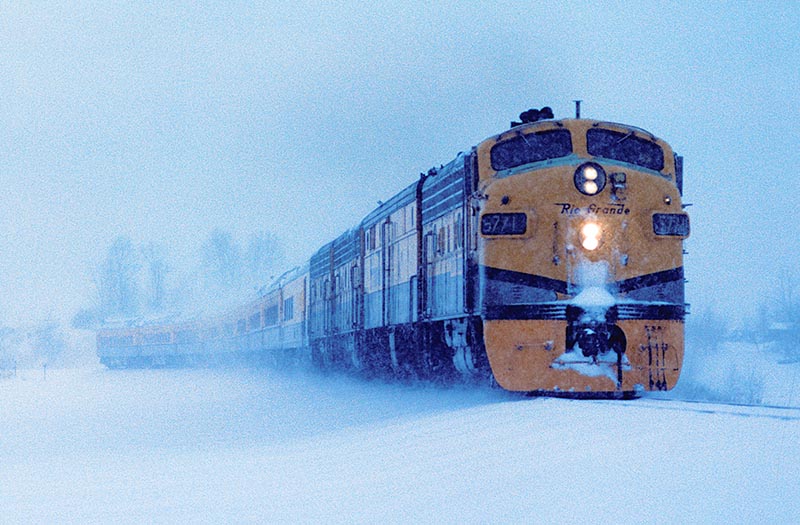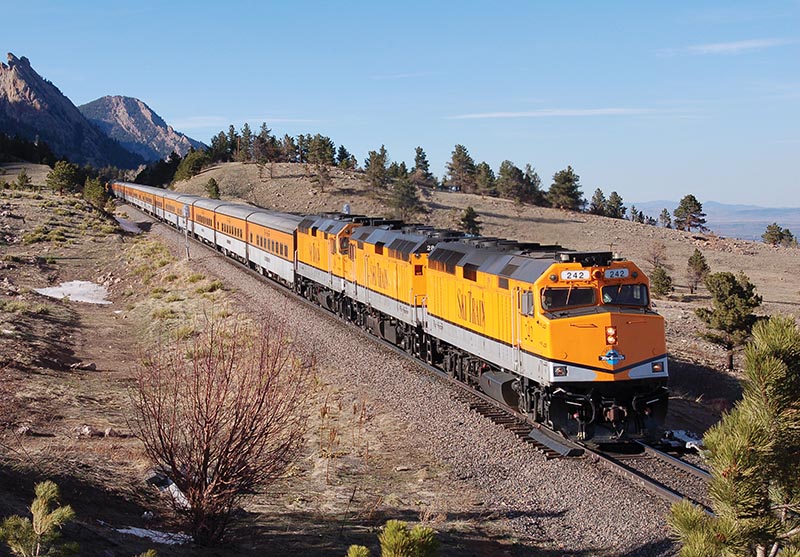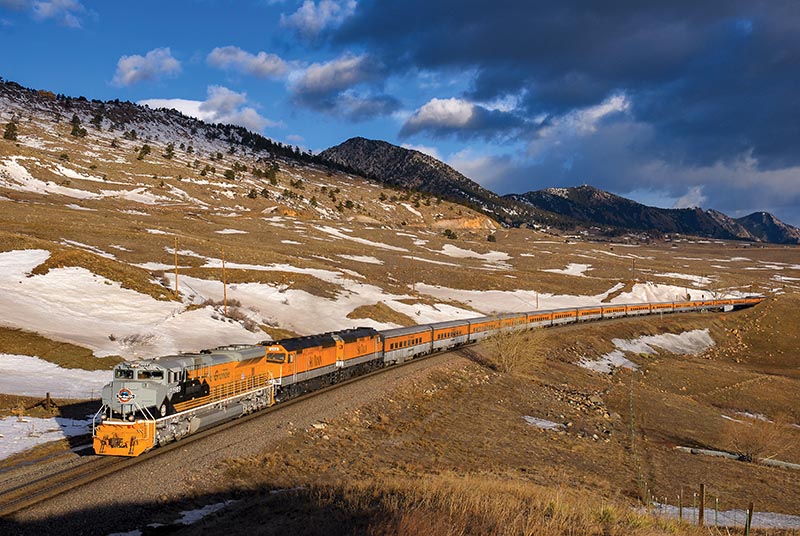 by Steve Patterson/photos as noted
by Steve Patterson/photos as noted
When Union Pacific was building the first Transcontinental Railroad westward from Omaha, Neb., it clipped across the northeast corner of Colorado at Julesburg, bound for its destiny at Promontory, Utah. Hardly two years old, the new city of Denver was terribly upset it wasn’t on the first railroad’s map. So the city leaders incorporated their own railroad to build from Cheyenne, Wyo., down to Denver. Banker David Moffat was selected as treasurer for Denver Pacific, the first railroad building into the state.
Railroading became so infectious to Moffat that he determined he could build a railroad due west out of Denver into the Rocky Mountains and on to Salt Lake City. Being the richest man in the state with his gold and silver mines, Moffat began his Denver, Northwestern & Pacific (DNW&P) in 1902, but within five years he was spending much of his time in Europe or New York City seeking more investors to keep the construction going.
His wealth and health depleting, Moffat died of pneumonia in a New York City hotel on March 18, 1911, propitiously before his DNW&P entered bankruptcy in early spring 1912 (it emerged from receivership in 1913, known as the Denver & Salt Lake Railroad). But while DNW&P was on the verge of bankruptcy, two Norwegian immigrants were about to make history by riding one of Mr. Moffat’s trains shortly after Christmas 1911.
Carl Howelsen left Norway for America in 1905 seeking a better life, and settled in Chicago, becoming a stonemason. Carl had already won several prizes for his skiing abilities in Norway, and longed for good snow around Chicago. Unable to find any good skiing in the Midwest, he boarded a Pullman in March 1909 and headed for Denver, joining a bricklayers union a month later.
Having already skied some nearby mountains, on that December 1911 morning, Carl and fellow Norwegian Angell Schmidt boarded DNW&P Train 1. With their 35-pound backpacks, their skis, and a rifle each, they rode to the highest point reached by rail on the Continental Divide in Colorado. They stepped off at Corona on 11,660-foot Rollins Pass, looking for the best snow. Due to limited daylight at that time of the year, they decided to head westward to take advantage of what light there was.

D&RGW F9A 5771, which led the Rio Grande Zephyr for more than a decade in the 1970s and early 1980s, leads two B-units, a steam heater made from an Alco PB unit, and the Ski Train through a storm at Arvada, Colo., on January 14, 1984. Steve Patterson photo
They skied 44 miles all the way to Hot Sulphur Springs where, much to their surprise, they found townspeople frolicking in the snow with skating contests and sled races. Quickly and enthusiastically, they asked organizer John Peyer (who was from Switzerland) if they could construct a ski jump to show everyone what they did in Norway. Everyone had such a good time they decided to do it again in six weeks, telling the crowd they would return the same way, riding a train to the top and skiing all the way down. The first Winter Sports Carnival at Hot Sulphur Springs in February 1912 was heavily promoted and eventually became an annual event.
Carl explored the mountains of Colorado wherever a train could take him. Joining him were local ski pioneers like George Cranmer and Marjorie Perry. Their exploits were like a Sunday picnic — stopping at natural hot springs to boil their eggs and sausages while they rested. While many skiers today attest to the same phenomenon, Carl found the best snow at Steamboat Springs and made it his home, conveniently on the D&SL. He raised hogs and grew strawberries while building higher and higher ski jumps; he was disappointed Americans did not teach their children a love of outdoor winter sports as was done in Norway. Howelson Hill became the training ground for U.S. winter Olympic athletes and still is, inspiring our nation’s youth to achieve the way Carl envisioned.
About a decade after he arrived in Colorado, Carl received a letter from his sister in Norway wanting him to come home for their parents’ golden wedding anniversary. On February 22, 1921, after getting off the D&SL train at Corona, he made one last sentimental trek down a familiar trail to Fraser with Marjorie Perry and other close companions. Despite becoming the undisputed father of Colorado’s ski industry, Carl never came back to America.
At his parents’ wedding anniversary, Carl met his future wife Anna, and at age 46 became a father. He wrote to George Cranmer that he felt it more important to stay in Norway with his aging parents than to return to his beloved Colorado mountains. In spite of several strokes, the “Flying Norseman” (as his son called him) skied and competed in contests for seniors right up to his death in 1955 at age 78.

Three F40PHs lead the Ski Train east at Plainview, Colo., on March 17, 2007. When this photo was taken, the original version of the Ski Train had just a year left. Tom Byrnas photo
The Ski Train is Born
By 1936, the Great Depression was winding down and Coloradoans were suffering from cabin fever. Rocky Mountain News sports editor Chet Nelson had noticed that those winter carnivals in Hot Sulphur Springs, now known as the U.S. Western Ski Tournament and Winter Sports Carnival, were coming up on their 25th anniversary. Why not encourage the residents of Denver to go to the carnival, he thought, and maybe they could get the railroad to run a special train. So, the newspaper chartered a train for February 9, 1936, and tickets were just $1.75. Downtown Denver merchants got into the excitement, too, and began advertising winter clothing as well as a breakfast that morning so people could eat before boarding the train. The response was so overwhelming that when 2,200 tickets had been sold, Denver & Salt Lake decided to operate three special trains to carry all the enthusiasts.
That became the first ski train in Colorado, and it operated at least once each winter for the next four years through the 6.2-mile-long Moffat Tunnel to Hot Sulphur Springs. However, there wasn’t much maintenance at the Hot Sulphur Springs hill and it soon fell into disrepair.
Meanwhile, the city of Denver was looking to get into the ski business itself and, at the suggestion of city parks manager George Cranmer, was eyeing an area around the old sawmill at the west portal of Moffat Tunnel that usually got ample amounts of powder. In January 1940, the city opened up the Winter Park Ski Resort, and from then on a dedicated ski train took skiers (and later snowboarders) to Winter Park.
Another prominent player in the life of the Ski Train was Frank Bulkley, an avid skier who began the Eskimo Ski Club, a ski school that took city kids to the mountains every weekend by bus. Demand for the school grew so much, though, that Frank began using regular D&SL passenger trains. But even then, there were still too many zealous youngsters being left behind…
Listen to an interview with author Steve Patterson this month on The Roundhouse Podcast with Nick Ozorak available now!



